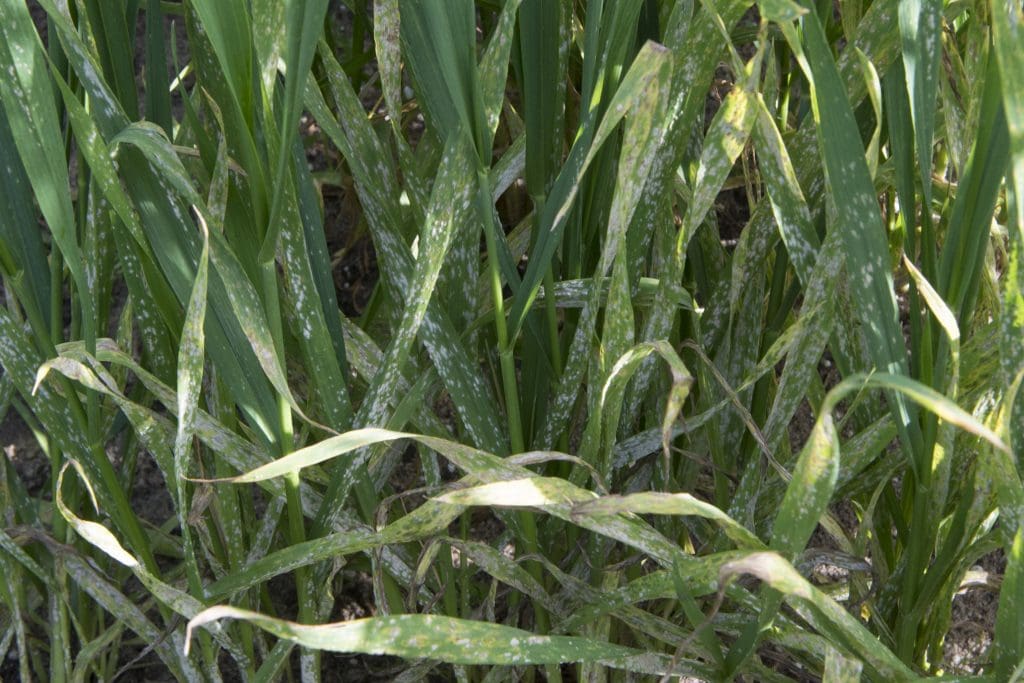DESPITE the forecast for a drier than average start to the growing season in Western Australia, growers should carefully review the disease ratings for the varieties in their cropping programs this year.

Wheat growers have been reminded to update management plans for wheat diseases, especially if sowing new varieties this year, to avoid the risk of crop losses from threats like powdery mildew (pictured.)
WA Department of Regional Development and Primary Industries (DPIRD) research officer Geoff Thomas said although the risk from several diseases was potentially lower than last year, it was important for growers not to be complacent.
“Every variety has its strengths and its weaknesses and it’s important for growers to research and understand the disease risks to their crop – particularly if they are sowing a new variety,” Mr Thomas said.
“Then growers can develop a risk mitigation plan for their cropping program in context to the mix of varieties they have sown and the seasonal disease risk.
“The level of disease a variety develops and the requirement for and response to in-season disease management is directly related to the resistance ranking of a variety.”
While Mace continues to be the most widely sown wheat in WA, its successor, Scepter, is expected to increase in area this year.
Mr Thomas said both varieties, like most available variety choices, were vulnerable to the fungal disease powdery mildew, with the disease ratings indicating Scepter is more susceptible than Mace.
“Mace has a moderately susceptible to susceptible rating, while Scepter is regarded as susceptible,” he said.
“Landholders growing these varieties in areas conductive to powdery mildew would be wise to budget for some fungicide, especially if the seasonal forecast improves.”
The department’s pathology team has updated its Wheat Disease Ratings for 40 varieties to 13 wheat diseases, including foliar diseases, crown rot and root lesion nematodes.
A complete spread of disease ratings are also provided for new varieties, including Cutlass, Scepter, DS Pascal, LRPB Arrow, Ninja, Tungsten, Chief CL Plus, and LRPB Havoc.
“Ninja, the highest yielding Australian noodle wheat, should be monitored in spring for stem rust because it is rated as susceptible to very susceptible to the disease,” Mr Thomas said.
“LRPB Havoc, an Australian Hard wheat, was released in 2017 and is also susceptible to stem rust so monitoring is also recommended in spring. However, this variety has a moderate resistance or better to stripe and leaf rust.”
In addition to variety selection, disease severity is also influenced by the amount of inoculum carried over from the previous season, seasonal conditions and the virulence of the pathotype.
Growers are urged to monitor their crops for diseases regularly during the growing season and contribute any observations to the department’s Pestfax e-newsletter.
The Wheat Disease Update for 2018 is available on the department’s website, as well as additional information on seed dressing and fungicide options and essential information to grow a successful wheat crop.
Growers can stay up to date with crop disease developments as the season unfolds by subscribing to the department’s free Pestfax e-newsletter by emailing [email protected] or report a suspected disease via its Pestfax Reporter app.
Source: DPIRD, GRDC
Grain Central: Get our free daily cropping news straight to your inbox – Click here

HAVE YOUR SAY